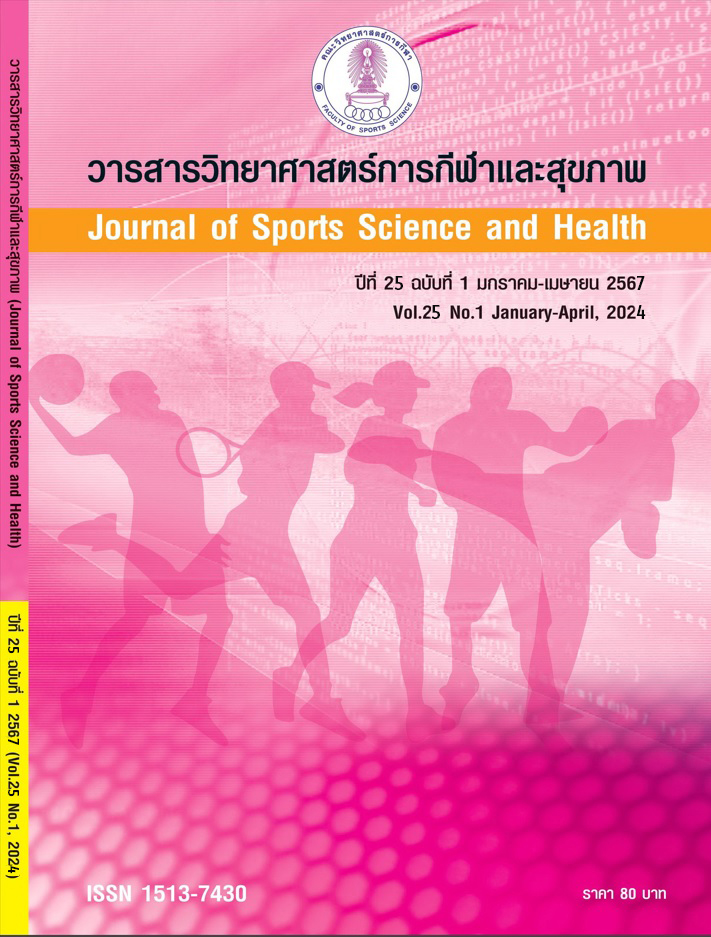ผลของการฝึกเน้นความหนักเอกเซ็นตริกที่มีต่อการเพิ่มสมรรถภาพกล้ามเนื้อขาในนักวิ่งระยะสั้นระดับเยาวชน
Main Article Content
บทคัดย่อ
วัตถุประสงค์
เพื่อศึกษาผลของการฝึกเน้นความหนักเอกเซ็นตริกที่มีต่อสมรรถภาพของกล้ามเนื้อขาในนักวิ่งระยะสั้นระดับเยาวชน
วิธีการดำเนินการวิจัย
กลุ่มตัวอย่างที่ใช้ในการวิจัยครั้งนี้ เป็นนักวิ่งระยะสั้นโรงเรียนกีฬาจังหวัดอ่างทอง เพศหญิง อายุระหว่าง 16-18 ปี จำนวน 20 คน ซึ่งได้จากการเลือกแบบเฉพาะเจาะจง (Purposive sampling) ก่อนทำการทดลอง กลุ่มตัวอย่างจะได้รับการฝึกด้วยแรงต้านในท่าแบคสควอทด้วยเครื่องสมิธแมชชีน (Smith machine) ที่ความหนัก 60% ของน้ำหนักที่มากที่สุดที่ยกได้อย่างถูกต้อง 1 ครั้ง จำนวน 15 ครั้ง 3 เซต 2 ครั้งต่อสัปดาห์ เป็นเวลา 2 สัปดาห์ เพื่อพัฒนาความแข็งแรงและให้คุ้นเคยกับการออกกำลังกายด้วยแรงต้าน หลังจากนั้นทำการแบ่งกลุ่มตัวอย่างออกเป็น 2 กลุ่มๆละ 10 คน ด้วยวิธีการกำหนดกลุ่มแบบจับคู่ โดยใช้ความแข็งแรงสัมพัทธ์เป็นเกณฑ์ กลุ่มที่ 1 กลุ่มทดลอง ฝึกเสริมด้วยโปรแกรมฝึกเน้นความหนักเอกเซ็นตริกที่ระดับความหนักเอกเซ็นตริกต่อคอนเซ็นตริก 105/85 % ของ 1 อาร์เอ็ม และกลุ่มที่ 2 เป็นกลุ่มควบคุมฝึกซ้อมตามโปรแกรมปกติที่มีการฝึกทักษะการวิ่งแบบต่างๆ โดยไม่มีการฝึกซ้อมด้วยน้ำหนักใดๆ กลุ่มทดลองทำการฝึกในสัปดาห์ที่ 1 และ 2 จำนวน 3 เซต สัปดาห์ที่ 3 และ4 จำนวน 4 เซต และสัปดาห์ที่ 5 และ 6 จำนวน 5 เซตๆ ละ 6 ครั้ง 2 ครั้งต่อสัปดาห์ เป็นเวลา 6 สัปดาห์ ก่อนและหลังการทดลอง 6 สัปดาห์ ทำการทดสอบพลังสูงสุด แรงปฏิกิริยาสูงสุด ความเร็วสูงสุด ความแข็งแรงสัมพัทธ์ และเวลาในการวิ่งระยะ 10 เมตร, 20 เมตร, 30 เมตร และ 40 เมตร นำข้อมูลที่ได้มาหาค่าเฉลี่ยและส่วนเบี่ยงเบนมาตรฐาน เปรียบเทียบความแตกต่างของข้อมูลก่อนและหลังการทดลองสัปดาห์ที่ 6 ภายในกลุ่มโดยการทดสอบค่าทีแบบสัมพันธ์กัน และเปรียบเทียบข้อมูลระหว่างกลุ่มทดลองและกลุ่มควบคุมหลังการทดลองโดยใช้การทดสอบค่าทีแบบเป็นอิสระจากกัน กำหนดระดับความมีนัยสำคัญทางสถิติที่ระดับ 0.05
ผลการวิจัย
หลังการทดลองสัปดาห์ที่ 6 พบว่า กลุ่มที่ฝีกเสริมด้วยโปรแกรมฝึกเน้นความหนักเอกเซ็นตริก มีค่าพลังกล้ามเนื้อขา ความแข็งแรงสัมพัทธ์ของกล้ามเนื้อขาเพิ่มขึ้น และเวลาในการวิ่งระยะ 10 เมตร, 20 เมตร, 30 เมตร และ 40 เมตร ลดลงอย่างมีนัยสำคัญทางสถิติที่ระดับ 0.05 ขณะที่กลุ่มควบคุมมีค่าความแข็งแรงสัมพัทธ์ของกล้ามเนื้อขาเพิ่มขึ้น และเวลาในการวิ่งระยะ 10 เมตร, 20 เมตร, 30 เมตร และ 40 เมตร ลดลงอย่างมีนัยสำคัญทางสถิติที่ระดับ 0.05 และเมื่อเปรียบเทียบระหว่างกลุ่มพบว่ากลุ่มที่ฝึกเสริมด้วยโปรแกรมฝึกเน้นความหนักเอกเซ็นตริกมีค่าความแข็งแรงสัมพัทธ์ของกล้ามเนื้อขาเพิ่มขึ้น และเวลาในการวิ่งระยะ 10 เมตร ลดลงมากกว่ากลุ่มควบคุมอย่างมีนัยสำคัญทางสถิติที่ระดับ 0.05 ขณะที่ตัวแปรอื่นไม่พบความแตกต่าง โดยเมื่อเปรียบเทียบเปอร์เซ็นต์การพัฒนาในทุกๆตัวแปรพบว่ากลุ่มที่ฝึกเสริมด้วยโปรแกรมฝึกเน้นความหนักเอกเซ็นตริกมีแนวโน้มดีกว่าในกลุ่มควบคุม
สรุปผลการวิจัย
การฝึกเน้นความหนักเอกเซ็นตริกเป็นระยะเวลา 6 สัปดาห์สามารถพัฒนาพลังของกล้ามเนื้อขาความแข็งแรงสัมพัทธ์ของกล้ามเนื้อขา และเวลาในการวิ่งระยะ 10 เมตร, 20 เมตร, 30 เมตร และ 40 เมตร ผลการทดลองนี้สามารถนำไปประยุกต์ใช้ในการฝึกสมรรถภาพกล้ามเนื้อขาของนักวิ่งระยะสั้นระดับเยาวชนได้
Article Details

This work is licensed under a Creative Commons Attribution-NonCommercial-NoDerivatives 4.0 International License.
References
Aagaard, P., Simonsen, E.B., Andersen, J.L., Magnusson, P., & Dyhre-Poulsen, P. (2002). Increased Rate of Force Development and Neural Drive of Human Skeletal Muscle Following Resistance Training. Journal of Applied Physiology, 93(4), 1318-1326.
Bobbert, M.F., Gerritsen, K.G., Litjens, M.C., & Van Soest, A.J. (1996). Why Is Countermovement Jump Height Greater Than Squat Jump Height? Medicine and Science in Sports and Exercise, 28, 1402-1412.
Bosch, F., & Klomp, K. (2001). Running: Biomechanics and Exercise Physiology Applied in Practice. Maarssen, The Netherlands: Churchill Livingstone.
Brandenburg, J. E., & Docherty, D. (2002). The Effects of Accentuated Eccentric Loading on Strength, Muscle Hypertrophy, And Neural Adaptations in Trained Individuals. The Journal of Strength & Conditioning Research, 16(1), 25-32.
Bruggemann, G., And Glad, B. Time Analysis of The Sprint Events. In G. Bruggemann, And B. Glad (Eds.) Scientific Research Project at The Game of Xxivth Olympiad-Seoul 1988, Internation Athletic Foundation, 1990: Pp.11-89
Chakshuraksha, P. (2021). The Effect of Accentuated Eccentric Complex Training on Leg Muscular Performance in Male Rugby Players. Master’s Thesis, Faculty of Sports Science, Chulalongkorn University. Bangkok.
Chakshuraksha, P., & Apanukul, S. (2021). Effects of Accentuated Eccentric Loading Combined with Plyometric Training on Strength, Power, Speed, And Agility in Male Rugby Players. Journal of Exercise Physiology Online, 24(3), 21-29.
Cromie, P., Mcguigan, M. R., & Newton, R. U. (2010). Influence of Strength on Magnitude and Mechanisms of Adaptation to Power Training. Medicine and Science in Sports and Exercise, 42(8), 1566-1581
Cronin, J. B., & Hansen, K. T. (2005). Strength and Power Predictors of Sports Speed. The Journal of Strength & Conditioning Research, 19(2), 349-357.
Cronin, J., Mcnair, P. J., & Marshall, R. N. (2001). Developing Explosive Power: A Comparison of Technique and Training. Journal of Science and Medicine in Sport, 4(1), 59-70.
Cook, C. J., Beaven, C. M., & Kilduff, L. P. (2013). Three Weeks of Eccentric Training Combined with Overspeed Exercises Enhances Power and Running Speed Performance Gains in Trained Athletes. The Journal of Strength & Conditioning Research, 27(5), 1280-1286.
Duchateau, J., & Enoka, R. M. (2016). Neural Control of Lengthening Contractions. Journal of Experimental Biology, 219(2), 197-204.
Dalleau, G., Belli, A., Viale, F., Lacour, J. R., & Bourdin, M. (2004). A Simple Method for Field Measurements of Leg Stiffness in Hopping. International Journal of Sports Medicine, 25(03), 170-176.
Douglas, J., Pearson, S., Ross, A., & Mcguigan, M. (2017). Eccentric Exercise: Physiological Characteristics and Acute Responses. Sports Medicine (Auckland, N.Z.), 47(4), 663-675.
Friedmann-Bette, B., Bauer, T., Kinscherf, R., Vorwald, S., Klute, K., Bischoff, D., Müller, H., Weber, M.A., Metz, J., Kauczor, H.U., Bärtsch, P., & Billeter, R. (2010). Effects of Strength Training with Eccentric Overload on Muscle Adaptation in Male Athletes. European Journal of Applied Physiology, 108(4), 821-836.
Godard, M.P., Wygand, J.W., Carpinelli, R.N., Catalano, S., & Otto, R.M. (1998). Effects of Accentuated Eccentric Resistance Training on Concentric Knee Extensor Strength. The Journal of Strength & Conditioning Research, 12(1), 26-29.
Hortobagyi, T., Devita, P., Money, J., & Barrier, J. (2001). Effects of Standard and Eccentric Overload Strength Training in Young Women. Medicine & Science in Sports & Exercise, 33(7), 1206-1212.
Haff, G.G., & Nimphius, S. (2012). Training Principles for Power. Strength & Conditioning Journal, 34(6), 2-12.
John, A., Glendenning, A. C., Marchant, A., Montgomery, P., Stewart, A., Wood, S., Lloyd, K., & Hawton, K. (2018). Self-Harm, Suicidal Behaviours, and Cyberbullying in Children and Young People: Systematic Review. Journal of medical Internet research, 20(4), e129. https://doi.org/10.2196/jmir.9044
Komi, P.V., & Bosco, C. (1978). Utilization of Stored Elastic Energy in Leg Extensor Muscles by Men and Women. Medicine and Science in Sports, 10(4), 261-265.
Lindstedt, S.L., Lastayo, P.C., & Reich, T.E. (2001). When Active Muscles Lengthen: Properties and Consequences of Eccentric Contractions. Physiology, 16(6), 256-261.
Moore, C.A., Weiss, L.W., Schilling, B.K., Fry, A.C., & Li, Y. (2007). Acute Effects of Augmented Eccentric Loading on Jump Squat Performance. The Journal of Strength & Conditioning Research, 21(2), 372-377.
Nelson, M. (2023). Using Genetic Testing in Order to Improve Retention Rates in Youth Sports.
Phungern, A., & Yimlamai, T. (2021). Effects of Plyometric and Eccentric Training on Achilles Tendon Stiffness in Male Long-Distance Runners. Journal of Sports Science and Health. 22(2), 217-229.
Schoenfeld, B.J. (2010). The Mechanisms of Muscle Hypertrophy and Their Application to Resistance Training. The Journal of Strength & Conditioning Research, 24(10), 2857-2872.
Weineck, J. (1990). Functional Anatomy in Sports. 2nd Ed. St. Louis: Mosby-Year Book.

